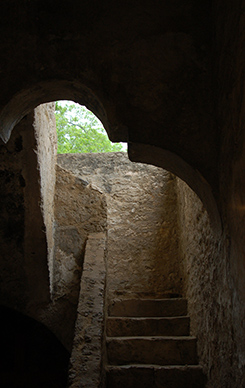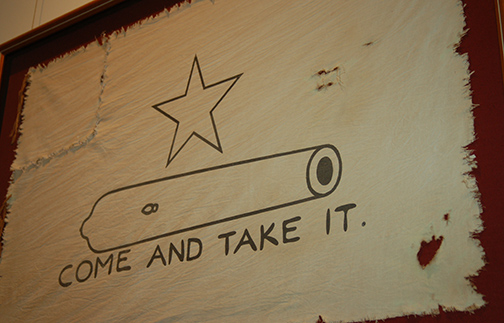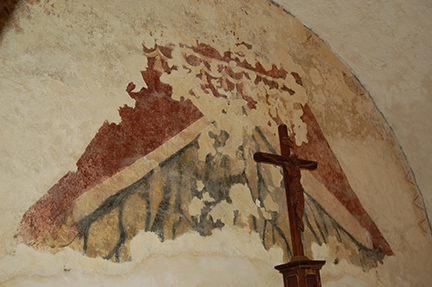William rode 'day and night' to join the battles
Settlers in Bastrop had already started organizing when the first skirmish with Mexican troops was fought at Gonzales. A Mexican army officer had asked the townspeople to return a cannon loaned to them, but the town refused and fought off a company of Mexican troops. The Mina Volunteers met September 28 and elected Jesse Billingsley captain. William was part of the group, which followed Edward Burleson’s leadership. William later said that he “rode day and night” to get to Gonzales after hearing word of the fighting there.
Volunteer militia from all over Texas were gathering at the town, along with regular Texas army units. Noah Smithwick described the first Texas army: “Buckskin breeches were the nearest approach to uniform, and there was wide diversity even there, some being new and soft and yellow, while others, from long familiarity with rain and grease and dirt, had become hard and black and shiny.” When buckskin got wet and then dried out while the wearer was seated at a campfire, the knees stretched out and pulled up the pantlegs, exposing the shins.
“Boots being an unknown quantity, some wore shoes and some moccasins,” Smithwick wrote. As for hats, some men wore broad sombreros; others wore military caps, tall “beegums,” or coonskin caps, complete with tails. The horses ranged from large American breeds to Spanish ponies, half-broken mustangs, and even mules. Packed on the horses were rolls of bed quilts, or store-bought blankets, buffalo robes, and even “one gaily checkered counterpane.”
Men had to carry water as well as bedding, and in place of canteens, many used a Spanish gourd, which Smithwick described as “two round bowls holding nearly a quart, connected by short neck, with a strap.”
Stephen Austin also arrived, and he gave an inspiring speech. Though he didn’t want to take the military leadership, many felt he could best unite the colonists. He and other leaders had hoped that Mexico would return to being a republic governed by its constitution of 1824 and honor its agreements with the colonists. But General Santa Anna, as dictator, had been moving through Mexican provinces, putting down rebellions and solidifying his power.
Mexico had moved the capital of the province of Coahuila y Tejas to a distant city and announced it would treat colonists as foreigners and possibly quarter troops in their homes. Feeling there was no effective military or police force to aid them, the settlers had started forming their Committees for Public Safety. In late June, William had enlisted for six months, and now his duties shifted from being a ranger to becoming a militiaman who would fight the Mexican troops.

Mission Conception is largely unrestored; some of its surrounding wall remains.
On October 27, Austin sent James Fannin and Jim Bowie with ninety-two men to scout for a good location to launch an attack against the Mexican army in San Antonio, called Bexar at the time. Two missions being used as forts would be critical: The Alamo, to the east, and Mission Conception, to the south.
William joined the scouting group, as did Noah Smithwick. After inspecting the old missions of San Jose and San Juan, the group approached Mission Conception. Austin had ordered the scouts to return by evening, but they disobeyed and camped for the night along a wooded bend of the river. At the time, the mission was about a mile and half south of the village of San Antonio.
Juan Seguin, a Tejano, or Mexican resident of the area, joined the Texans, ready to lead his men in battle against Mexican troops. He later recounted that they realized Mexican scouts near Mission Conception had observed them, and they spent the night preparing defenses along the riverbank.
Under cover of a dense fog that night, General Martin Perfecto de Cos sent 275 Mexican troops under Colonel Domingo de Ugartechea, and two cannons, across the river.
As Jim Bowie recounted, "The engagement commenced about 8 o'clock a. m. by the deadly crack of a rifle from the extreme right. The action was immediately general. The discharge from the enemy was one continued blaze … A brass six pounder was opened on our line at the distance of 80 yards … and a charge sounded. But the cannon was cleared as if by magic and a check put to the charge …. ”
Smithwick recalled that volleys flew into the pecan trees overhead, showering the Texans with falling nuts. Dense trees prevented the Mexican cavalry from making formations, and their gunpowder was of such poor quality that the bullets often bounced off the Texans’ buckskin clothing. The Texans drove back three Mexican charges and then counterattacked, capturing a cannon.
A stairway in the mission leads up to a bell tower. After leading Robert Coleman's company to meet an advance by the Mexican troops, Jim Bowie charged to the mission and took control of one of the towers.
He stationed militia there and stayed on to wave a waved a flag from up above. Other volunteers criticized his actions, saying they kept him away from the main fighting.

The battle was brief; one Texan, Richard Andrews from Bastrop, was killed, and another was wounded. Mexican losses were fourteen killed, and thirty-nine wounded, though Bowie reported larger numbers, concluding, “Thus a detachment of ninety-two men gained a complete victory over part of the main army of Central Government being at least four to one.”
After the victory, Austin wanted to continue with an attack on San Antonio, but other officers felt it was too well defended. When Austin left to attend the Consultation, the meeting of the provisional government, he handed over command to Edward Burleson, of Bastrop.
Burleson did not want to try taking the city. However, Ben Milam, who had just returned from scouting on December 4, urged pressing the attack. He famously rallied the men by shouting, “Who will go with old Ben Milam into San Antonio?” As hundreds came forward, Burleson ended up going along with the plan.
William Magill was one of the 300 volunteers who stepped forward. But as the fighting began, he most likely was outside of the city and the hand-to-hand combat, for Burleson used units from the Bastrop area to run the supply lines. On December 7, the second day of battle, Milam was shot in the head by a sniper and died instantly. The siege lasted five days, with General Cos surrendering on December 9.
William returned home, along with most other volunteer militiamen, after this victory. He was twenty-two years old, and he had been in the field, rangering and soldiering, almost continuously for six months. Colonists had to work their land or risk losing their headright claims, and they had to harvest any crops they’d put in, as well as cut wood and make other preparations for winter.
But some stayed near San Antonio and took up residence at The Alamo. Jim Bowie became head of the volunteer militia, which drew notable frontiersmen such as David Crockett. William Travis became leader of the regular troops stationed there.
The Texans knew that their war was not over, but that not much would happen during the winter, while rain and storms made the roads and ports impassable. With spring, though, they expected General Santa Anna to move north with the main Mexican Army to put down the rebellion in their province.


